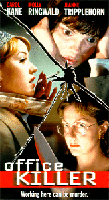st.carol kane, molly ringwald, jeanne tripplehorn, barbara sukowa, michael imperioli.

The main drawpoint of this film is of course the fact that it is directed by Cindy Sherman, the avant garde artist made famous by her Untitled Film Stills series, and then her advertising project for Commes des Garçons. Someone once told me that Sherman was high on art theory but low on film ideas. At the time there was a kernel of truth in it, because Sherman still hadn't directed any movies, a logical change in media for her.
In Untitled Film Stills, a series of photographs, Sherman poses as different characters caught as if in the middle of a film. Literally, an Untitled Film Still! (Duh.) Sherman? genius evoked frozen actions and nascent moments that we expect from film and not photographs, but producing a series of photographs is still different to creating one and a half hours of continuous footage. Altie/ indie film company Good Machine (connected to Hal Hartley and Ang Lee), obviously thought it would be an artistic service for the world to get Sherman to direct, if not profitably amusing.
In an interview Sherman said that the experience was enjoyable but not all that exciting. After all, she was used to being the ultra-auteur in her photographs, at once director, cinematographer and actor. Like any good, obsessive compulsive, rabidly slathering editor, to relinquish control is not joyful, but terrifying. However, Sherman did say that she felt as if she still had a sense of control over the movie despite her amateurity in this field.
The movie itself contains a great sense of Sherman. People often see in her film stills a feminist eye of sorts, and say that Sherman's works rearrange and redefine the male gaze. The male gaze is a feminist theory, which states that women (especially the naked variety) are always filmed, painted or photographed as if a man was watching. This is possibly a load of feminist dogma and debates have raged since its inception. Nevertheless it is possible that having a female artist direct a horror movie has some unexpected results.
There is a very obvious lack of aggression in Office Killer, for instance. The death-as-sex-as-death thrill seeking is not to be found in Office Killer as it is in other slasher movies or postmodern concoctions such as the Screams. Here the horror is played for farce, for schlock, and sometimes even just a complicated nose wrinkling of "uh" and "eeew". There is no real good or bad, no posturing about the ultimate evil descending to destroy mankind. There is no demon, no id monster, no warlock. When I think about the idea, I want to yell "Bravo! C'est horreur intelligence!" but the end result of bloodlessness is... well, bloodlessness.
Still, it is vaguely liberating watching Carol Kane's Dorine find a way across this hostile office landscape, after a lifetime of being dumped on. So what if she kills all the other characters? They all suck anyway. The first victim is a sleazebag, the last a self-righteous embezzler, and the only survivor the bitchy secretary. They aren? even sexy victims running around in tartlet underwear. (Which, on an interesting note, is what the dorky jockboy test audience expected. "You mean Molly Ringwald keeps her clothes ON? This, like, sucks, duuuuude!" Strangely this attitude was reflected in most of the other reviews that I've read for this movie. It appears that people don't like their assumptions fucked with.)
Here, the dead aren't objects of shock or terror as they are in classicist horrors. Instead, they become dolls dressed up by Sherman via Dorine, acting out a weird little how-to tale about constructing a family from dead people, which isn't surprising when Dorine so much resembles Bette Davis·Baby Jane, with the same need for fantasy. Baby Jane killed people to maintain the illusion, because they were agents of reality. Dorine is much more devious - she kills totally unwitting toadies and then uses them to construct the perfect, obedient family she never had.
A notable scene is Sherman's conscious redefinition of the male gaze. As Bobby the Mail Boy sits in his jeans and white sweater, he brings out a hetero porn mag. His hair in a Dirk Diggler do, he flicks the pages, oblivious of his upcoming demise. Behind the shelves Dorine watches, a predator lurking as slash killers do in other horror movies, waiting for the moment to plunge hot axe into blood. Or in Dorine's case, what looks like a food processor blade.
It is unfortunate that Sherman fumbles the ball and doesn't go all the way with this role reversal, which really says it all about the film. That is, although oriented along a number of interesting ideas, it isn't all that exciting, preferring to savour pretty but superficial scene arrangements, or even to play with conventionality in genre confusions. A case of too many cooks spoil the broth, or at least, the head cook not knowing exactly what to do with the ingredients, making it lumpy and slightly saltless.
Huan-tzin Goh
comments? email the authorreviews | features | archive
toto :: cinema matters
Get a cheap magazine subscription and support toto at the same time!
Premiere is a highly-regarded monthly film magazine that takes readers behind the scenes of newly released and soon-to-be-released films. The magazine answers questions about the business and art of moviemaking and helps readers get a better understanding of cinema. Premiere also features interviews, profiles, and film commentary. You can save 65% off the regular cover price if you subscribe through us.
